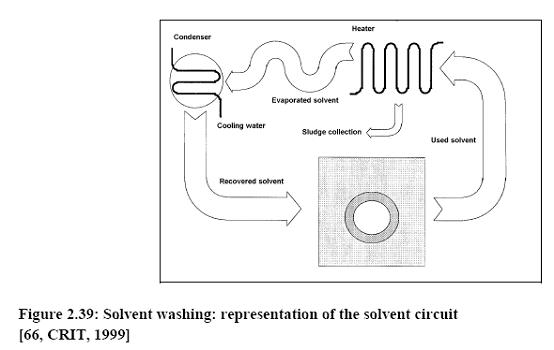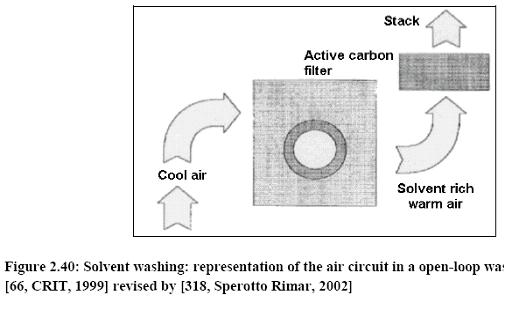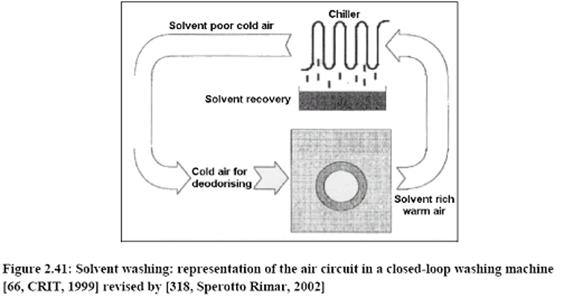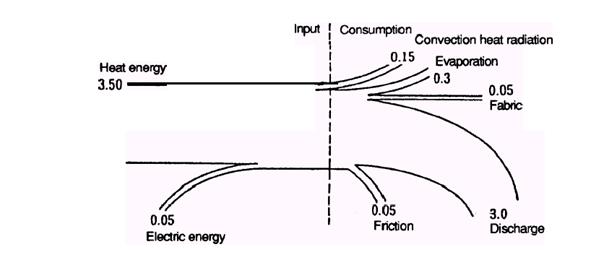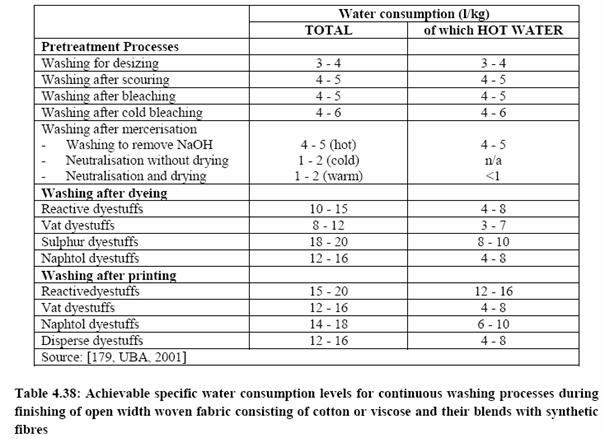Washing/Rinsing in textile industry
Back to EFFICIENCY FINDER FOR TEXTILE INDUSTRY
1. OBJECTIVE
Washing is used to remove impurities from the surface of fibres, yarns and fabrics.
2. FIELD OF APPLICATION
Washing is a finishing process applied to fibres, yarns and fabrics. Dry cleaning is especially used for delicate fibres (BAT for the Textiles Industry, July 2003).
3. DESCRIPTION OF TECHNIQUES, METHODS AND EQUIPMENT
- Washing with water
- (BAT for the Textiles Industry, July 2003)
Important factors in washing are:
- water characteristics
- choice of soaps and detergents
- hydro mechanical action
- temperature and pH
- rinsing stage
Washing is normally carried out in hot water (40-100°C) in the presence of wetting agent and detergent. The detergent emulsifies the mineral oils and disperses the undissolved pigments. The choice of the surfactants may vary also depending on the type of fibre. Mixtures of anionic and non-ionic surfactants are commonly used. An important factor in the selection of a surfactant is its effectiveness in strong alkaline conditions.
Washing always involves a final rinsing step to remove the emulsified impurities.
Fabric washing can be carried out in rope form or open-width, and both in discontinuous or in continuous mode. The most commonly used technique is continuous mode in open-width.
- Dry cleaning
- (BAT for the Textiles Industry, July 2003)
Industrial solvent washing is sometimes necessary especially for delicate fabrics. In this case the impurities are carried away by the solvent, which is usually perchloroethylene. In the same step, softening treatments may also be carried out. In this case, water and surfactant-based chemicals are added to the solvent.
Solvent washing may be carried out continuously in fully width (for woven or knitted fabric) or discontinuously with yarn or fabrics in rope form (generally for knitted fabric).
Solvent plants have a built-in solvent treatment and recovery system in which the solvent is purified by distillation and re-used for the next washing process. Residual sludge from distillation must be disposed of as a hazardous waste in case of high concentration of solvent.
After distillation, the solvent must be cooled before re-use and thus high amounts of cooling water are required. This water is never contaminated by solvent and can therefore be re-used. In mills having both solvent and water washing facilities, warm water from the cooling plant may be used for washing treatments, allowing water and energy savings. In many cases, however, this water is not re-used and it is discharged together with the other effluents.
Both closed and open airflow circuits can be used for the removal of solvent from fabric.
In open circuit machines, when the washing cycle is over, large amounts of air taken from the external environment, warmed up with a steam heat exchanger and introduced into the machine, thus obtaining the evaporation of the organic solvent. This process goes on until the solvent is almost completely eliminated from clean fabrics. Solvent-rich-air is then sent to a centralised activated charcoal filtering system. Filters require regular regeneration to ensure optimal cleaning performance. Most modern filters allow discharge into the atmosphere below 3 – 4 mg/m3. In closed circuit machines the volume of air used to carry out the drying process, instead of being filtered and released into the atmosphere, is internally treated. Such treatment consists in recovering the solvent by condensation using a chiller. When the solvent has been removed from air and recovered, solvent-poor-air is heated by a heat-exchanger and then sent again inside the machine. Recovered solvent is sent to a centralised plant, where it is distilled and purified. Closed circuit machines do not require an active carbon filter.
Figure 2.39, 2.40 and 2.41 show the solvent and the air circuits in open and closed loop solvent washing machines (the solvent circuit is always closed).
The following figure gives an example of energy balance in typical continued washing machine:
Fig. 4: Example of Energy Balance in Typical Continued Washing Machine Literature: E.P Dempsey & C.E. Vellings, Heat Transfer Printing p.46, Interprint 1975
4. COMPETITIVE TECHNOLOGIES AND ENERGY SAVING POTENTIALS
- a) Changes in the process
- Water & energy conservation in batch washing and rinsing: (BAT for the Textiles Industry, July 2003)
Washing and rinsing are two of the most common operations in the textile industry. Optimisation of washing efficiency can conserve significant amounts of water and energy.
In batch processes, typical washing and rinsing techniques include:
- drain and fill rinsing
- overflow or “flood” rinsing
In overflow rinsing, clean water is fed into the machine and drained through an overflow weir, usually set near the normal running level. This technique is useful for removing the surface scum resulting from poor quality water, chemicals or from inefficient pretreatment, but it is inefficient in terms of water consumption, especially in machines with high liquid ratio.
Better options are:
A) The drain and fill method
The drain and fill method is a more efficient technique in terms of water consumption. Here, rinsing is achieved by successive fill, run and drain steps. Among the various factors playing a role in this process, it is worth noting the influence of liquor ratio and draining time on risning efficiency, as calculated using the equation below.
Cf = Cs x R/L.R, where
Cf ……….. Concentration of solute in the substrate rinse bath
Cs ……….. Concentration of solute in the previous bath
R ………… retention capacity (or carry-over) of the substrate (l/kg)
L.R. ……… liquor ratio (l/kg)
From the equation it can be demonstrated that at lower liquor ratios more rinsing steps are required in order to achieve the same dilution effect, but actually using less water. The following example for cotton dyeing with reactive dyes clearly shows this. Considering an exhausted dye liquor containing 60 g/l electrolyte, with a retention capacity of the substrate of 3 l/kg (R) and a liquor ratio of 1:15 (L.R.), the concentration of electrolyte Cf in the subsequent rinse bath after one drain/fill operation will be 12 g/l and after two drain/fill operations will be 2.4 g/l. Conversely, if the liquor ratio is reduced to 1:7, Cf becomes 26 g/l and 11 g/l, respectively, for one and two subsequent rinses.
Moreover the substrate in the machine retains much of the previous bath, which is expressed by the R parameter (retention capacity). This can be reduced by proper draining (increasing draining times) or, in some batch machines (e.g. yarn package dyeing, stock dyeing), by using compressed air or vacuum blowdown between washing steps. The main disadvantages of the traditional drain & fill rinsing method are:
- the longer production cycle time, which means lower productivity
- the thermal shock to which the substrate is submitted during the first rinsing
- the deposition of scum on the substrate between rinses as the liquor drains. This means that the removed chemicals or impurities can re-deposit on the surface of the textile material, especially if the machine is re-filled with cold water
All these limitations have been solved in modern machinery.
As for the cycle time, the machines are equipped with special time-saving devices (power draining and filling, combined cooling and rinsing, full volume heated tanks, etc.), which allows shorter time cycles compared to traditional “overflow” rinsing.
The thermal shock during the first rinsing step can be avoided using the “combined cooling and rinsing” system. This is again a common feature of modern machinery, which allows simultaneous cooling and rinsing of the processed textile. Clean water is introduced through the jet/overflow nozzle after it has been preheated by passing it through either the machine’s main heat exchanger or an external high-efficiency plate heat exchanger. The contaminated waste liquor is then drained.
Deposition of scum on the substrate remains a limitation of the “drain & fill” method. This is why batch dyeing machines are designed to allow rinsing in either the “drain & fill” or the “smart rinsing” mode. The latter, which is described below, is a “controlled overflow” method that can be used for the first rinsing step before switching to the drain & fill mode.
B) “Smart rinsing” systems
The use of low liquor ratio machines is a specific requirement for effective use of smart rinsing systems. Rinsing is achieved by feeding clean water into the machine and draining it through an overflow weir set low down in the dyeing machine. In addition, the clean water flow in the machine is regulated at an equivalent rate to that of the liquor draining through the low-level overflow. Compared to traditional overflow rinsing, the dilution effect is increased thanks to the reduced volume of contaminated liquor circulating in the machine. The technique is particularly efficient when hot water is used for rinsing. This can be done in an efficient way by “combined cooling and rinsing”, which allows simultaneous cooling and rinsing of the processed textile as described above.
In this case the final concentration of the solute at the end of the rinsing sequence is given by the following equation:
Cf = Cs x exp [-(Rt/Vk), where
Cf ……….. Final concentration of the solute
Cs ………. starting concentration of the solute
R ………... Flow rate of incoming fresh liquor (l/min)
t ………… Rinsing time (min)
Vk ……… Volume of liquor bath (l)
The liquor ratio is one determinant factor: the higher the liquor volume, the longer is the rinsing time required (and therefore the higher the water consumption) to reach the same dilution effect at the same flow rate. The flow rate R also significantly influences rinsing efficiency. If the rate is reduced, longer rinsing times are needed to achieve the same end point, but this time the water consumption would be unaltered.
Further process optimisation may be achieved by applying systems such as on-line conductivity meters to signal the attainment of a pre-set concentration of salt (when suing reactive dyes) or by colorimeters to facilitate rinsing to the optimum end point.
Main achieved environmental benefits
Drain and fill and smart rinsing are both more efficient in terms of water consumption than conventional overflow rinsing.
As far as the drain and fill method is concerned, by replacing each overflow rinse by 2 – 4 “drain and fill” cycles a reduction of 50 – 75 % water consumption can be achieved.
Reduced water consumption also means reduced energy consumption, since hot and warm rinsing steps are often required. In addition, energy savings are obtained with combined cooling and rinsing techniques.
One fundamental feature of both “smart rinsing” and drain & fill compared to the conventional overflow method is that it is possible to keep the exhausted concentrated dye liquor and the rinsing waters as separate streams. This means that they can be re-used or at least treated separately and thermal energy can thus be recovered.
Operational data
As in any productivity improvement, the fist step should be a complete audit (and possible upgrading) of utilities to ensure that the benefits of the new equipment can be exploited to the full.
- Water and energy conservation in continuous washing and rinsing: (BAT for the Textiles Industry, July 2003)
Most of the finishing processes involve washing and rinsing stages. In continuous operating mode in particular, washing after dyeing, printing, etc. consumes greater quantities of water than the dyeing and printing steps themselves.
Water (and energy) conservation can be achieved by increasing the washing efficiency, but a considerable improvement can often be obtained with the application of simple low-technology (good housekeeping) measures.
A) Water flow control
In practice, mills measure and keep control of water use. Every mill should have water meters that can be installed on individual machines to document water use and evaluate improvements. Significant water reduction has been observed in industry experience after the installation of cheap flow control devices on washers. A systematic procedure can be applied aimed at defining the optimum flow needed to achieve the desired level of product quality. Automatic stop valves that link the main drive mechanism of the range to the water flow can save considerable quantities of energy and water by shutting off water flow as soon as a stoppage occurs. With manual control, the water flow may not be switched off until the machine has stopped for more than 30 minutes.
B) Increasing washing efficiency
Many factors influence washing efficiency (e.g. temperature, residence time, liquor/substrate exchange, etc.). The techniques applied in modern washing machines depend largely on the type of fabric to be washed, e.g. light or very heavy fabrics, etc. Two basic principles/strategies are applied in modern machines: countercurrent washing and reduction of carry-over.
The countercurrent principle means that the least contaminated water from the final wash is reused for the next-to-last wash and so on until the water reaches the first wash stage, after which it is discharged. This technique is relatively straightforward and inexpensive and can be applied for washing after continuous desizing, scouring, bleaching, dyeing or printing.
A washer configuration with internal countercurrent (and recycling) capacities is the vertical counter-flow washer, which sprays recirculated water onto the fabric and uses rollers to squeeze waste through the fabric into a sump, where it is filtered and recirculated. This construction allows for high-efficiency washing with low water use. Energy use decreases greatly because less water must be heated.
Reduction of carry over is another fundamental factor. Water (containing contaminants) that is not removed is “carried over” into the next step, contributing to washing inefficiency. Proper extraction between steps is essential. In continuous washing operations, squeeze rollers or vacuum extractors (more efficient) are used to reduce drag-out and carry-over.
Wash boxes with built-in vacuum extractors are available for purchase as well as after-printing washers that combine successive spray and vacuum slots without any bath for the fabric to pass through.
C) Introduce heat recovery equipment
Installing heat recovery equipment on a continuous washer is usually a simple but effective measure, since water inflow and effluent outflow are matched, eliminating the need for holding tanks. The effluent from these machines can become contaminated with fibrous material, so it is important to install heat exchangers capable of handling such loads (e.g. self-cleaning elements).
Main achieved environmental benefits
All measures described contribute to overall reduction of water and energy consumed. In order to allow full exploitation of the benefits achievable with the new advanced washing machinery, the implementation of the low-technology measures is fundamental.
Operational data
The table below shows the achievable water consumption levels for washing cotton and viscose woven fabric and their blends with synthetic fibres. The values for the different processes are additive and were submitted by machine manufacturers and confirmed by some finishing mills.
It is worth pointing out that the achievable performances are influenced by the degree of implementation of complementary techniques. Low water consumption levels can only be achieved by synergistic combination of different possible measures, from the preparation of the fabric through the process chain (e.g. low add-on application techniques for sizing agents, selection of dyes with good washing off properties, etc.).
- b) Changes in the energy distribution system
No information is available.
- c) Changes in the heat supply system
No information is available.
